One Mud Monkey's Adventure in Organic Gardening
“Gardening is the art that uses flowers and plants as paint, and the soil and sky as canvas.”
-Elizabeth Murray
Monday, November 24, 2008
A garden nut's book review...
Can I just say that I'm reading Animal, Vegetable, Miracle a Year of Food Life by Barbara Kingsolver and am seriously *loving* it? Cause I am. I am such a garden nut. I keep wanting to transcribe whole paragraphs here but realized that it was about every other one... I might as well just type up the whole book! lol... or you know, you could just go read it, n' stuff.
Sunday, November 23, 2008
Slow Progress
I managed to muck about in the garden for a few hours before lunch. Got more of the compost** into the raised beds and was able to dig out two more walkway areas. I know it never sounds like much but I was sweating! And it was cold out! Really - at this rate I will never need a gym membership. I'm also excited because on Friday we're going down to DH's Uncle's house for a big family post-Thanksgiving Thanksgiving thing and we're bringing 'Ol Penny (our truck) to pick up some scrap wood from him we can use to frame out some more beds and walkways with! Oh, and it'll be nice to visit with them too I guess. ((Heehee)) I'll take some pictures as soon as it looks like I've done anything!
**Note to self: Do not leave a giant pile of oderiffic compost in the back alley for any length of time as the local feline population will use it as largest most magnificent kitty litter box - ever! ::stupid poopy cat poop::
**Note to self: Do not leave a giant pile of oderiffic compost in the back alley for any length of time as the local feline population will use it as largest most magnificent kitty litter box - ever! ::stupid poopy cat poop::
Friday, November 21, 2008
Fall Cleanup
It was crisp out - 46° but it felt great to go outside and rake leaves and snip away the last of the dying bulbs. Of course there's still loads to do (when isn't there?) but I filled one of the 60 gallon yard recycling bins so for now I'll call it good. I have one more bin which I could also easily fill - too bad they only pick them up once every other week. We called it a day when the babe started complaining her hands were cold. It looks good! I can't believe that we're still getting dahlias. I thought about cutting them to the quick but couldn't bring myself to do it as they're so prolific! I left the canna's in too for now. The edges of their leaves are starting to brown with the colder temperatures but they've still got a week or two of life in them still.
Thursday, November 13, 2008
I. Am. So. Tired!
Oh man. Who needs a gym when you can build garden beds and re-landscape your back yard?
I. Am. So. Tired!
I have a feeling too that tomorrow that sentence will read: I am so sore! I raked up one dogwood's worth of fallen leaves while waiting for compost to show up. Once it got here I shoveled 1/2 yard of compost into the blueberry bed and 1/2 yard into one of the raised beds. I shoveled up a bunch of really wet heavy clay-e clumpy soil (it's been pouring here for days so the earth is *soaked*) out of the walkways between the beds and into the beds...
Picture of pre-dug clumpy heavy wet dirt
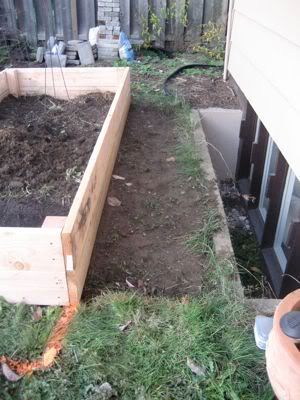
...then raked it up, tamped it down and lined it with landscape fabric.
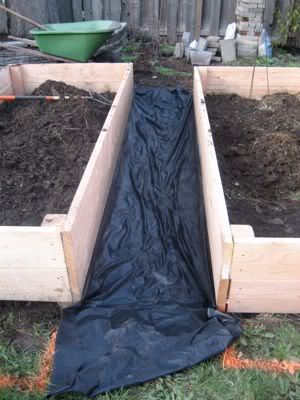
Ran off to the rock place and picked up 1/2 yard of 1/4" minus crushed aggregate which was also soaked by the rain. For those of you who haven't had the pleasure of shoveling wet 1/4" aggregate, it's akin to shoveling wet cement. Bleh. Anyway I got nearly all it into one of the walkways, leveled it, raked it and tamped it down. It looks *awesome*! I think so anyway. I just wish it was all done! So much more to do...

Whew~
And of course overall, it looks like I did - nothing.
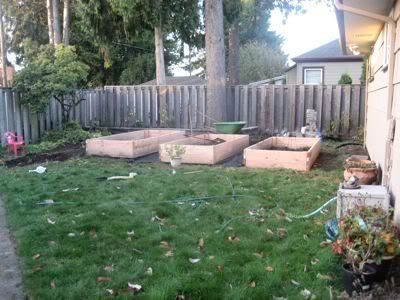
lol... ah well. I think it's supposed to be sunny tomorrow too so if I'm not too dead I guess I'll be back at it. I do have other things on the docket though so it won't be the all day endeavor that it was today. I was also thinking that I could do little ground level beds in front of the raised ones. I would plant things that were good insect attractants like lavendar (bees) and insect repellents like nasturtiums (aphids, squash bugs & striped pumpkin beetles) and peppermint (white cabbage butterflies) etc. while the 1/4" minus would continue in a little path around it. Of course that means I need to convince DH to get the tiller back out and churn up some more of our so called lawn. Heh.

I. Am. So. Tired!
I have a feeling too that tomorrow that sentence will read: I am so sore! I raked up one dogwood's worth of fallen leaves while waiting for compost to show up. Once it got here I shoveled 1/2 yard of compost into the blueberry bed and 1/2 yard into one of the raised beds. I shoveled up a bunch of really wet heavy clay-e clumpy soil (it's been pouring here for days so the earth is *soaked*) out of the walkways between the beds and into the beds...
Picture of pre-dug clumpy heavy wet dirt

...then raked it up, tamped it down and lined it with landscape fabric.

Ran off to the rock place and picked up 1/2 yard of 1/4" minus crushed aggregate which was also soaked by the rain. For those of you who haven't had the pleasure of shoveling wet 1/4" aggregate, it's akin to shoveling wet cement. Bleh. Anyway I got nearly all it into one of the walkways, leveled it, raked it and tamped it down. It looks *awesome*! I think so anyway. I just wish it was all done! So much more to do...

Whew~
And of course overall, it looks like I did - nothing.

lol... ah well. I think it's supposed to be sunny tomorrow too so if I'm not too dead I guess I'll be back at it. I do have other things on the docket though so it won't be the all day endeavor that it was today. I was also thinking that I could do little ground level beds in front of the raised ones. I would plant things that were good insect attractants like lavendar (bees) and insect repellents like nasturtiums (aphids, squash bugs & striped pumpkin beetles) and peppermint (white cabbage butterflies) etc. while the 1/4" minus would continue in a little path around it. Of course that means I need to convince DH to get the tiller back out and churn up some more of our so called lawn. Heh.

Labels:
back yard,
blueberries,
compost,
garden planning,
kitchen garden,
landscaping,
plans
Tuesday, November 11, 2008
Garden beds in! Blueberries planted!
It was a very productive weekend for the mud monkey family. We got a lot done in the back yard and after waiting four loooong years I finally got my raised garden beds in! I'm beyond ecstatic... possibly euphoric. I *LOVED* having a kitchen garden and it's been a long time in coming since we moved here that I have one again. I'm dreaming of beautiful fruit and vegetables next year. I'm drooling over seed catalogs and trying to figure out how I can cram all the things I want to grow into such a small space - I have four years to catch up on! For example I need purple carrots. Why? I dunno, cause now I CAN. lol...
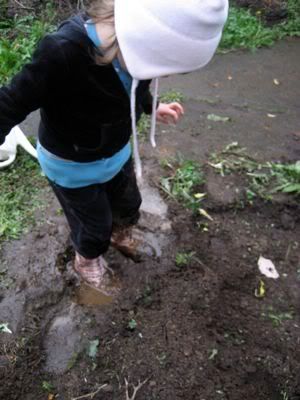
I'm almost even more excited just about the fact that the weeds will be gone (at least in this section of yard). There's structure and purpose now! I'm really stupidly happy. Really.
So Friday DH took the kiddlet and went to borrow a garden tiller. When they got back he tilled up the blueberry bed then I asked if he'd till up the lawn where the raised beds would go someday ::blink-blink:: Little did he realize my plot to get them in this week. It worked better then I thought though as they're in there tonight! But I digress.
On Friday after he tilled the blueberry bed I did a soil test to see where the pH level was. For blueberries it needs to be acidic (4.5 - 5.0) but my test came out neutral (7.0). It seemed off to me. I assumed that this soil would be acidic as it sits under an evergreen tree that drops it's needles all the time. Plus with the higher amounts of rain we get here our soil tends to be acidic anyway. I was really surprised by a neutral reading. So I picked up a pH soil meter on Saturday and plunked it in the ground and also got a pH reading of 7.0. Oooookay. So I stuck it in peat moss (a highly acidic soil amendment) and got a reading of 7.0. I'm taking the damn meter back. lol... Ah well. I still don't know exactly what my pH is and I could have the county extension office run a soil test but that'd put me back $50 I don't have. So I crossed my fingers and added sulfate to the bed (an amendment that makes the soil more acidic). Hope I didn't over do it! Anyway it's done now! I know it doesn't look like much but those little bushes in the front will fill out 3' round and high. The two bushes in the back should get anywhere from 5' to 8' high and flush out as well. Once matured the yield should be about 10lb of berries a bush. *Almost* enough to keep kiddlet happy. The little blueberry junkie that she is. ;^)
So I picked up a pH soil meter on Saturday and plunked it in the ground and also got a pH reading of 7.0. Oooookay. So I stuck it in peat moss (a highly acidic soil amendment) and got a reading of 7.0. I'm taking the damn meter back. lol... Ah well. I still don't know exactly what my pH is and I could have the county extension office run a soil test but that'd put me back $50 I don't have. So I crossed my fingers and added sulfate to the bed (an amendment that makes the soil more acidic). Hope I didn't over do it! Anyway it's done now! I know it doesn't look like much but those little bushes in the front will fill out 3' round and high. The two bushes in the back should get anywhere from 5' to 8' high and flush out as well. Once matured the yield should be about 10lb of berries a bush. *Almost* enough to keep kiddlet happy. The little blueberry junkie that she is. ;^)
The rest of our time was spent working on the building the beds... It went okay except for the point where we ran out of screws and it started raining on us. Oh, and it's cold. I think the warmest it got today was 56°, it just got colder as the afternoon wore on.
IN PROGRESS
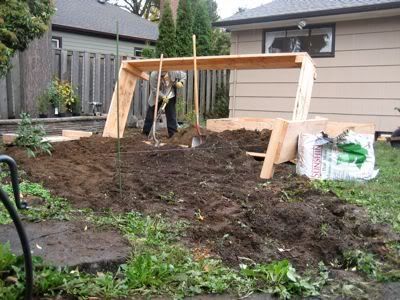
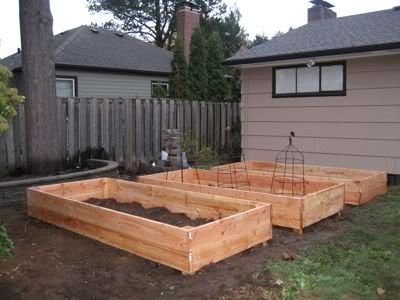
BEFORE & AFTER

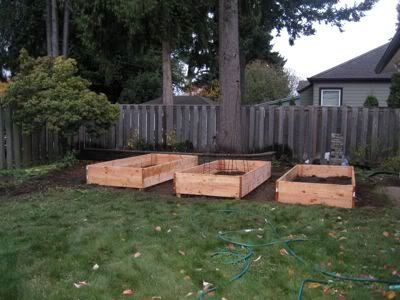
There is still more to do of course - fill the beds with compost and other yummy amendments - till them up. Add a top layer of compost to the blueberries and then mulch them with bark mulch. Plan out next years garden... but I'll have all winter for that last bit. Mmmm seed catalogs here I come!

I'm almost even more excited just about the fact that the weeds will be gone (at least in this section of yard). There's structure and purpose now! I'm really stupidly happy. Really.
So Friday DH took the kiddlet and went to borrow a garden tiller. When they got back he tilled up the blueberry bed then I asked if he'd till up the lawn where the raised beds would go someday ::blink-blink:: Little did he realize my plot to get them in this week. It worked better then I thought though as they're in there tonight! But I digress.
On Friday after he tilled the blueberry bed I did a soil test to see where the pH level was. For blueberries it needs to be acidic (4.5 - 5.0) but my test came out neutral (7.0). It seemed off to me. I assumed that this soil would be acidic as it sits under an evergreen tree that drops it's needles all the time. Plus with the higher amounts of rain we get here our soil tends to be acidic anyway. I was really surprised by a neutral reading.
 So I picked up a pH soil meter on Saturday and plunked it in the ground and also got a pH reading of 7.0. Oooookay. So I stuck it in peat moss (a highly acidic soil amendment) and got a reading of 7.0. I'm taking the damn meter back. lol... Ah well. I still don't know exactly what my pH is and I could have the county extension office run a soil test but that'd put me back $50 I don't have. So I crossed my fingers and added sulfate to the bed (an amendment that makes the soil more acidic). Hope I didn't over do it! Anyway it's done now! I know it doesn't look like much but those little bushes in the front will fill out 3' round and high. The two bushes in the back should get anywhere from 5' to 8' high and flush out as well. Once matured the yield should be about 10lb of berries a bush. *Almost* enough to keep kiddlet happy. The little blueberry junkie that she is. ;^)
So I picked up a pH soil meter on Saturday and plunked it in the ground and also got a pH reading of 7.0. Oooookay. So I stuck it in peat moss (a highly acidic soil amendment) and got a reading of 7.0. I'm taking the damn meter back. lol... Ah well. I still don't know exactly what my pH is and I could have the county extension office run a soil test but that'd put me back $50 I don't have. So I crossed my fingers and added sulfate to the bed (an amendment that makes the soil more acidic). Hope I didn't over do it! Anyway it's done now! I know it doesn't look like much but those little bushes in the front will fill out 3' round and high. The two bushes in the back should get anywhere from 5' to 8' high and flush out as well. Once matured the yield should be about 10lb of berries a bush. *Almost* enough to keep kiddlet happy. The little blueberry junkie that she is. ;^)The rest of our time was spent working on the building the beds... It went okay except for the point where we ran out of screws and it started raining on us. Oh, and it's cold. I think the warmest it got today was 56°, it just got colder as the afternoon wore on.
IN PROGRESS


BEFORE & AFTER


There is still more to do of course - fill the beds with compost and other yummy amendments - till them up. Add a top layer of compost to the blueberries and then mulch them with bark mulch. Plan out next years garden... but I'll have all winter for that last bit. Mmmm seed catalogs here I come!
Labels:
blueberries,
garden planning,
pictures,
plans,
retaining walls
Friday, November 7, 2008
I always wanted a "pet" bat...
Maybe I'll get a bat house for Christmas?

Source
How And Where To Put Up A Bat House
In Northwestern states, bat houses need at least six to eight hours of direct sun daily. It is very important for nursery colonies to raise their young under warm conditions. You should even paint your bat house black to absorb more heat. Use a non-toxic, latex paint for your house and only paint the outside. Remember that where you mount your bat house plays a major role in the internal temperature. Houses can be mounted on such structures as poles, sides of buildings and tall trees without obstructions. Houses placed on poles and structures tend to become occupied quicker than houses placed on trees. Houses should face south to southeast to take advantage of the morning sun. Your bat house should be mounted at least 15 feet above the ground, the higher the house the greater the chance of attracting bats. Bats return from migration and awaken from hibernation as early as March in most of the U.S., but stay active year-round in the extreme southern U.S. They will be abundant through out the summer and into late fall. Most houses used by bats are occupied in the first 1 to 6 months (during the first summer the bat house was erected). If bats do not roost in your house by the end of the second summer, move the house to another location.
What types of bats can I expect to see in my bat house in the Northwestern states?
Some of the most common bat species to occupy bat houses in northwestern states are as followed: pallid bat (Antrozous pallidus) a large pale colored bat with large ears, little brown bat (Myotis lucifugus), big brown bat (Eptesicus fuscus), Yuma myotis (Myotis yumanensis), and Mexican free-tailed bat (Tadarida brasiliensis), all of which are light to dark brown in color. For more information on identifying bats check out "Stokes Beginners Guide to Bat Identification."

Source
How And Where To Put Up A Bat House
In Northwestern states, bat houses need at least six to eight hours of direct sun daily. It is very important for nursery colonies to raise their young under warm conditions. You should even paint your bat house black to absorb more heat. Use a non-toxic, latex paint for your house and only paint the outside. Remember that where you mount your bat house plays a major role in the internal temperature. Houses can be mounted on such structures as poles, sides of buildings and tall trees without obstructions. Houses placed on poles and structures tend to become occupied quicker than houses placed on trees. Houses should face south to southeast to take advantage of the morning sun. Your bat house should be mounted at least 15 feet above the ground, the higher the house the greater the chance of attracting bats. Bats return from migration and awaken from hibernation as early as March in most of the U.S., but stay active year-round in the extreme southern U.S. They will be abundant through out the summer and into late fall. Most houses used by bats are occupied in the first 1 to 6 months (during the first summer the bat house was erected). If bats do not roost in your house by the end of the second summer, move the house to another location.
What types of bats can I expect to see in my bat house in the Northwestern states?
Some of the most common bat species to occupy bat houses in northwestern states are as followed: pallid bat (Antrozous pallidus) a large pale colored bat with large ears, little brown bat (Myotis lucifugus), big brown bat (Eptesicus fuscus), Yuma myotis (Myotis yumanensis), and Mexican free-tailed bat (Tadarida brasiliensis), all of which are light to dark brown in color. For more information on identifying bats check out "Stokes Beginners Guide to Bat Identification."
Saturday, November 1, 2008
Another reason to go organic
I thought this was a sad but very interesting article.
What's Causing Bats to Drop Like Flies?
Researchers look beyond white-nose syndrome as the prime suspect in the mysterious deaths of bats in the U.S. Northeast
The mortality rate of the bats is guestimated at 97%. Researchers are linking two of the three main reasons for their deaths to pesticides and insecticides but have no conclusive evidence as of yet. It just breaks my heart. I hope they're able to figure out what's causing the problem and help to correct it before it's too late...
What's Causing Bats to Drop Like Flies?
Researchers look beyond white-nose syndrome as the prime suspect in the mysterious deaths of bats in the U.S. Northeast
The mortality rate of the bats is guestimated at 97%. Researchers are linking two of the three main reasons for their deaths to pesticides and insecticides but have no conclusive evidence as of yet. It just breaks my heart. I hope they're able to figure out what's causing the problem and help to correct it before it's too late...
"Kunz and his team are approaching the mystery from three different angles: The first is to study the body weights of hibernating bats in different geographic areas by collecting samples of the creatures from three caves in the affected areas and from three caves in Ohio and Pennsylvania, where white-nose syndrome does not appear to have struck. Similar to Blehert's approach, this will inform Kunz and his team of whether the bats in the areas hit by the syndrome are beginning hibernation with the right amount of stored fat. If not, this might signal that pesticides are diminishing local insect populations, possibly choking off a primary food source for the bats.
The second angle is to determine whether the animals are storing the right type of fat (unsaturated fatty acids obtained by eating insects) for their dormancy, Kunz says. A lack of unsaturated fatty acids could again lead the scientists back to suspect declining local insect populations from insecticide use.
A third area to investigate is whether the bats' immune systems are being suppressed for some reason, making them more susceptible to fungal infection. "There's no smoking gun at this point," Kunz says, but he and his colleagues are collecting bat samples at this time and hope to have some results by December.
One possible bright spot is that some of the lesions on dead bats that Blehert and his colleagues examined had begun to heal before the bats died, which indicates that the bats are capable of fighting the infection to some extent. The researchers plan to spend this winter studying the effect of this fungus on healthy bats in the lab. Blehert says he will be surprised if the fungus alone was the sole culprit behind the plummeting bat population. "I'm not sure a fungus," he says, "can kill an otherwise healthy animal."
Subscribe to:
Posts (Atom)